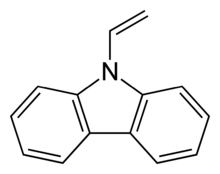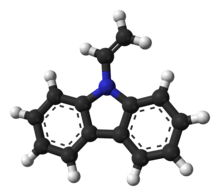N-Vinylcarbazole
N-Vinylcarbazole is an organic compound used as a monomer in the production of poly(vinylcarbazole),[3] a conductive polymer, in which conductivity is photon-dependent. The compound is used in the photoreceptors of photocopiers.[4] Upon exposure to γ-irradiation, N-vinylcarbazole undergoes solid-state polymerisation.[5]
 | |
 | |
| Names | |
|---|---|
| IUPAC name
9-ethenyl-9H-carbazole | |
| Other names
9-vinyl-9H-carbazole, NVC | |
| Identifiers | |
3D model (JSmol) |
|
| ChemSpider | |
| ECHA InfoCard | 100.014.596 |
| EC Number |
|
PubChem CID |
|
| RTECS number |
|
| UNII | |
CompTox Dashboard (EPA) |
|
| |
| |
| Properties | |
| C14H11N | |
| Molar mass | 193.244 g mol−1 |
| Appearance | pale brown crystalline solid[2] |
| Melting point | 66 °C (151 °F; 339 K) |
| Boiling point | 154 to 155 °C (309 to 311 °F; 427 to 428 K) 3 mmHg[2] |
| insoluble | |
| Solubility in diethyl ether | very soluble |
Except where otherwise noted, data are given for materials in their standard state (at 25 °C [77 °F], 100 kPa). | |
| Infobox references | |
It is produced by the vinylation of carbazole with acetylene in the presence of base.[6]
Related compounds
gollark: I think this is technically possible to implement, so bee⁻¹ you.
gollark: This is underspecified because bee² you, yes.
gollark: All numbers are two's complement because bee you.
gollark: The rest of the instruction consists of variable-width (for fun) target specifiers. The first N target specifiers in an operation are used as destinations and the remaining ones as sources. N varies per opcode. They can be of the form `000DDD` (pop/push from/to stack index DDD), `001EEE` (peek stack index EEE if source, if destination then push onto EEE if it is empty), `010FFFFFFFF` (8-bit immediate value FFFFFFFF; writes are discarded), `011GGGGGGGGGGGGGGGG` (16-bit immediate value GGGGGGGGGGGGGGGG; writes are also discarded), `100[H 31 times]` (31-bit immediate because bee you), `101IIIIIIIIIIIIIIII` (16 bits of memory location relative to the base memory address register of the stack the operation is conditional on), `110JJJJJJJJJJJJJJJJ` (16 bit memory location relative to the top value on that stack instead), `1111LLLMMM` (memory address equal to base memory address of stack LLL plus top of stack MMM), or `1110NNN` (base memory address register of stack MMM).Opcodes (numbered from 0 in order): MOV (1 source, as many destinations as can be parsed validly; the value is copied to all of them), ADD (1 destination, multiple sources), JMP (1 source), NOT (same as MOV), WR (write to output port; multiple sources, first is port number), RE (read from input port; one source for port number, multiple destinations), SUB, AND, OR, XOR, SHR, SHL (bitwise operations), MUL, ROR, ROL, NOP, MUL2 (multiplication with two outputs).
gollark: osmarksISA™️-2028 is a VLIW stack machine. Specifically, it executes a 384-bit instruction composed of 8 48-bit operations in parallel. There are 8 stacks, for safety. Each stack also has an associated base memory address register, which is used in some "addressing modes". Each stack holds 64-bit integers; popping/peeking an empty stack simply returns 0, and the stacks can hold at most 32 items. Exceeding a stack's capacity is runtime undefined behaviour. The operation encoding is: `AABBBCCCCCCCCC`:A = 2-bit conditional operation mode - 0 is "run unconditionally", 1 is "run if top value on stack is 0", 2 is "run if not 0", 3 is "run if first bit is ~~negative~~ 1".B = 3-bit index for the stack to use for the conditional.C = 9-bit opcode (for extensibility).
References
- Lide, David R. (2008). CRC Handbook of Chemistry and Physics, 89th Edition. CRC Press. pp. 3–518. ISBN 978-0-8493-0488-0.
- Sigma-Aldrich 9-Vinylcarbazole product page
- Conti, Francsco (June 2006). "Nuova via di sintesi del vinilcarbazolo". La Chimica & L'Industria (in Italian). Società Chimica Italiana (5): 82.
- G. Burton; J. Holman; J. Lazonby; G. Pilling; D. Waddington (2000). Chemical Storylines (2nd ed.). Heinemann Educational Publishers. pp. 121–122. ISBN 0-435-63119-5.
- K. Tsutsui; K. Hirotsu; M. Umesaki; M. Kurahashi; A. Shimada; T. Higuchi (1976). "Structural chemistry of polymerizable monomers. I. Crystal structure of N-vinylcarbazole". Acta Crystallogr. B. 32: 3049–3053. doi:10.1107/S0567740876009527.
- Pässler, Peter; Hefner, Werner; Buckl, Klaus; Meinass, Helmut; Meiswinkel, Andreas; Wernicke, Hans-Jürgen; Ebersberg, Günter; Müller, Richard; Bässler, Jürgen; Behringer, Hartmut; Mayer, Dieter (2008). "Acetylene Chemistry". Ullmann's Encyclopedia of Industrial Chemistry. doi:10.1002/14356007.a01_097.pub3. ISBN 3527306730.
This article is issued from Wikipedia. The text is licensed under Creative Commons - Attribution - Sharealike. Additional terms may apply for the media files.